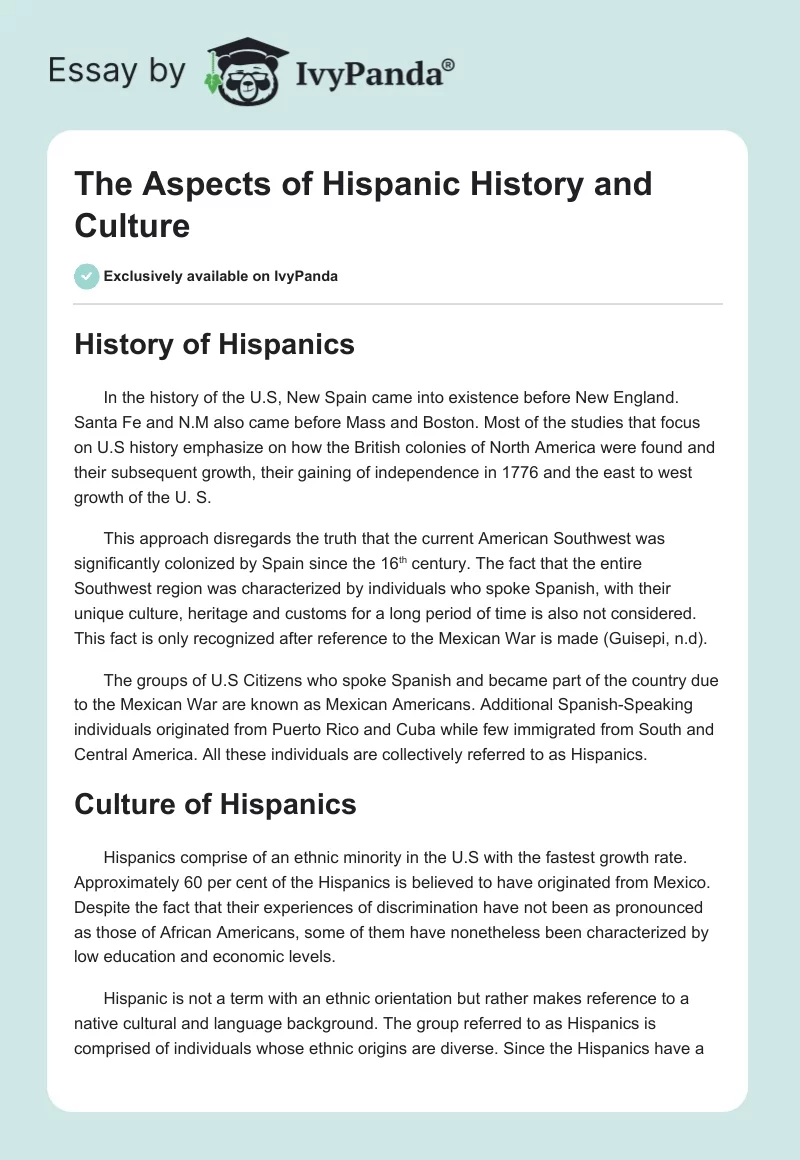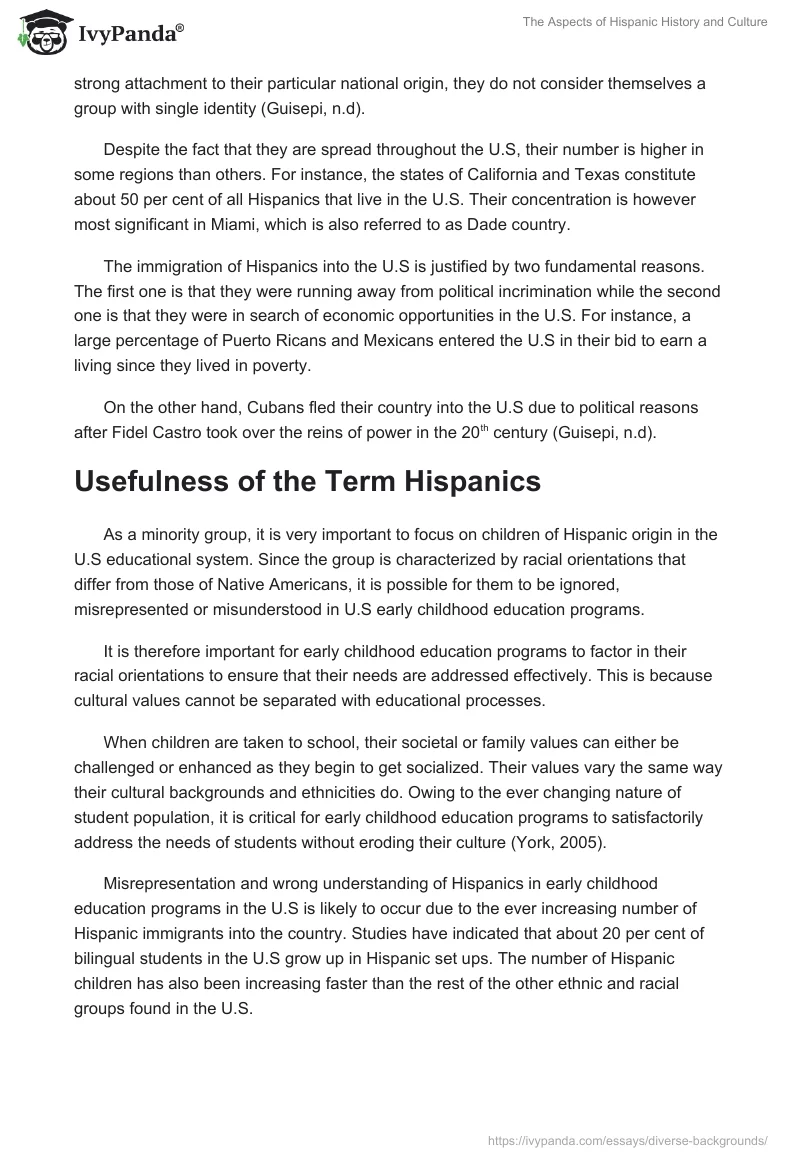History of Hispanics
In the history of the U.S, New Spain came into existence before New England. Santa Fe and N.M also came before Mass and Boston. Most of the studies that focus on U.S history emphasize on how the British colonies of North America were found and their subsequent growth, their gaining of independence in 1776 and the east to west growth of the U. S.
This approach disregards the truth that the current American Southwest was significantly colonized by Spain since the 16th century. The fact that the entire Southwest region was characterized by individuals who spoke Spanish, with their unique culture, heritage and customs for a long period of time is also not considered. This fact is only recognized after reference to the Mexican War is made (Guisepi, n.d).
The groups of U.S Citizens who spoke Spanish and became part of the country due to the Mexican War are known as Mexican Americans. Additional Spanish-Speaking individuals originated from Puerto Rico and Cuba while few immigrated from South and Central America. All these individuals are collectively referred to as Hispanics.
Culture of Hispanics
Hispanics comprise of an ethnic minority in the U.S with the fastest growth rate. Approximately 60 per cent of the Hispanics is believed to have originated from Mexico. Despite the fact that their experiences of discrimination have not been as pronounced as those of African Americans, some of them have nonetheless been characterized by low education and economic levels.
Hispanic is not a term with an ethnic orientation but rather makes reference to a native cultural and language background. The group referred to as Hispanics is comprised of individuals whose ethnic origins are diverse. Since the Hispanics have a strong attachment to their particular national origin, they do not consider themselves a group with single identity (Guisepi, n.d).
Despite the fact that they are spread throughout the U.S, their number is higher in some regions than others. For instance, the states of California and Texas constitute about 50 per cent of all Hispanics that live in the U.S. Their concentration is however most significant in Miami, which is also referred to as Dade country.
The immigration of Hispanics into the U.S is justified by two fundamental reasons. The first one is that they were running away from political incrimination while the second one is that they were in search of economic opportunities in the U.S. For instance, a large percentage of Puerto Ricans and Mexicans entered the U.S in their bid to earn a living since they lived in poverty.
On the other hand, Cubans fled their country into the U.S due to political reasons after Fidel Castro took over the reins of power in the 20th century (Guisepi, n.d).
Usefulness of the Term Hispanics
As a minority group, it is very important to focus on children of Hispanic origin in the U.S educational system. Since the group is characterized by racial orientations that differ from those of Native Americans, it is possible for them to be ignored, misrepresented or misunderstood in U.S early childhood education programs.
It is therefore important for early childhood education programs to factor in their racial orientations to ensure that their needs are addressed effectively. This is because cultural values cannot be separated with educational processes.
When children are taken to school, their societal or family values can either be challenged or enhanced as they begin to get socialized. Their values vary the same way their cultural backgrounds and ethnicities do. Owing to the ever changing nature of student population, it is critical for early childhood education programs to satisfactorily address the needs of students without eroding their culture (York, 2005).
Misrepresentation and wrong understanding of Hispanics in early childhood education programs in the U.S is likely to occur due to the ever increasing number of Hispanic immigrants into the country. Studies have indicated that about 20 per cent of bilingual students in the U.S grow up in Hispanic set ups. The number of Hispanic children has also been increasing faster than the rest of the other ethnic and racial groups found in the U.S.
Ways of Engaging with Hispanic Students
The bio-ecological dimension of looking at child development argues that the diversity of contextual factors that influence the development of children should be considered. Rogoff (2003) explains that the cultural development of children is biological.
This implies that culturally responsive education should be encouraged during the formative years of students in order to enhance development conditions that are both biologically and culturally appropriate. This involves the employment of prior experiences and cultural knowledge in order to increase the efficacy and appropriateness of learning. In such an approach, children are educated through their own strengths.
In addition, social, intellectual and emotional learning can be enhanced through cultural references to inculcate skills, knowledge and attitudes among the students. Teachers can also include cognition that is culturally mediated, social situations that are culturally relevant for learning and content that transmits culturally recognized knowledge. Finally, teachers who are culturally responsive emphasize the need for education to preserve cultural heritage and identity alongside teaching academic content.
Activities of Educating other Students about Hispanics
In order to ensure that Hispanic children are integrated into the early childhood education systems, it is important to educate other students on the importance of appreciating and honoring the culture and background of their Hispanic colleagues.
The first activity that teachers can use to educate other students on this is by giving students from Hispanic origin tasks that require them to integrate and interact with the rest of the students. By so doing, the other students learn to appreciate the culture and background of the Hispanics (York, 2005).
The second activity that teachers can use is to organize competitions that enable the Hispanic students bring out their best qualities and strengths. In such events, they might even exhibit the ability to do things that native students may not be able to do. As a result, they learn to appreciate the cultural diversity of the Hispanics.
Addressing Hispanics in Standard Curriculum
In order to address the Hispanic culture throughout the standard curriculum, a number of measures should be taken. The first measure is to promote acculturation or integration. This implies that the culture of the Hispanics should be valued and recognized throughout the curriculum as opposed to compelling Hispanic students to assimilate to American culture.
The second measure of addressing the culture throughout the curriculum is by recognizing common values and ideas that characterize different cultures while the third measure is being attentive to the needs of minority races to ensure that their concerns are fully addressed in the curriculum.
Some of the important resources that can be utilized include ‘The cultural nature of human development’ by Rogoff, Understanding development in a cultural context: The challenge for teachers by Bowman & Scott and Building on strength: Language and literacy in Latino families and communities by Zentella A.C
References
Guisepi, R. n.d. Hispanic Americans. Web.
Rogoff, B. (2003). The Cultural Nature of Human Development. New York: Oxford University Press.
York, S. (2005). Roots & wings:affirming culture in early childhood programs. New York: Prentice Hall.


